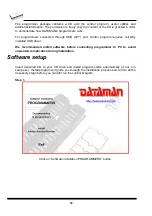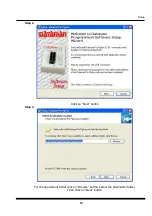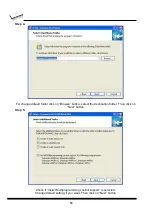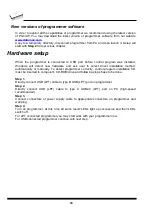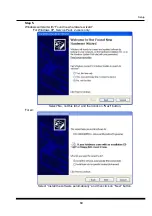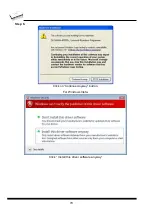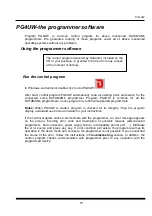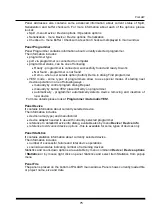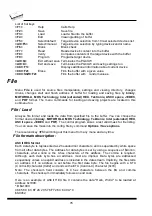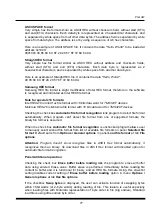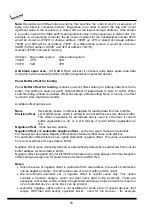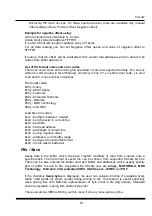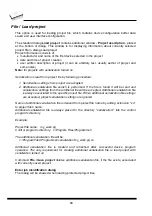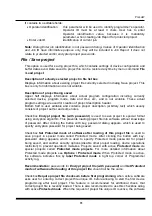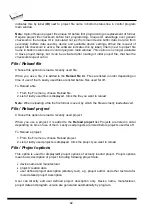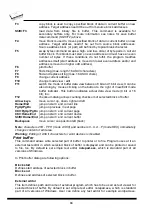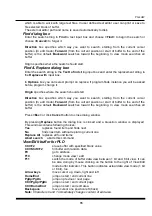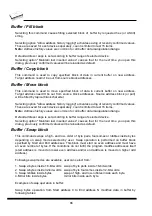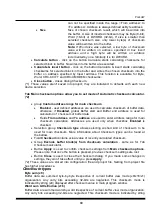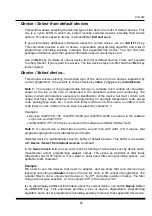
76
List of hot keys
<F1>
Help
Calls Help
<F2>
Save
Save file
<F3>
Load
Load a file into the buffer
<F4>
Edit
Viewing/editing of buffer
<F5>
Select/default
Target-device selection from 10 last selected devices list
<Alt+F5>
Select/manual
Target-device selection by typing device/vendor name
<F6>
Blank
Blank check
<F7>
Read
Reads device's content into the buffer
<F8>
Verify
Compares contents of the target device with the buffer
<F9>
Program
Programs target device
<Alt+Q>
Exit without save Terminates the PG4UW
<Alt+X>
Exit and save
Terminates the PG4UW and saving settings too
<Ctrl+F1>
Displays additional information about current device
<Ctrl+F2>
Erase
Fill's the buffer with a given value
<Ctrl+Shift+F2>
Fill's the buffer with random values.
File
Menu
File
is used for source files manipulation, settings and viewing directory, changes
drives, changes start and finish address of buffer for loading and saving files by
binary
,
MOTOROLA
,
MOS Technology
,
Intel (extended) HEX
,
Tektronix, ASCII space
,
JEDEC
,
and
POF
format. The menu commands for loading and saving projects are located in this
submenu too.
File / Load
Analyse file format and loads the data from specified file to the buffer. You can choose the
format desired (
binary
,
MOTOROLA
,
MOS Technology
,
Tektronix
,
Intel (extended) HEX
,
ASCII space
,
JEDEC
and
POF
). The control program stores a last valid mask for file listing.
You can save the mask into the config. file by command
Options / Save options
.
The reserved key
<F3>
will bring out this menu from any menu and any time.
File formats description:
ASCII HEX format
Each data byte is represented as 2 hexadecimal characters, and is separated by white space
from all other data bytes. The address for data bytes is set by using a sequence of $Annnn,
characters, where nnnn is the 4-hex characters of the address. The comma is required.
Although each data byte has an address, most are implied. Data bytes are addressed
sequentially unless an explicit address is included in the data stream. Implicitly, the file starts
an address 0 if no address is set before the first data byte. The file begins with a STX
(Control-B) character (0x02) and ends with a ETX (Control-C) character (0x03).
Note: The checksum field consists of 4 hex characters between the $S and comma
characters. The checksum immediately follows an end code.
Here is an example of ASCII HEX file. It contains the data "Hello, World" to be loaded at
address 0x1000:
^B $A1000,
48 65 6C 6C 6F 2C 20 57 6F 72 6C 64 0A ^C
$S0452,
Summary of Contents for Dataman-40Pro
Page 7: ...Quick Start 7 Introduction ...
Page 12: ...12 Quick Start ...
Page 15: ...Detailed description 15 Detailed description ...
Page 16: ...16 DATAMAN 448PRO2 ...
Page 30: ...30 DATAMAN 48PRO2 DATAMAN 48PRO2C ...
Page 45: ...DATAMAN 40PRO 45 DATAMAN 40PRO ...
Page 54: ...54 DATAMAN MEMPRO ...
Page 61: ...Setup 61 Setup ...
Page 72: ...72 PG4UW ...
Page 141: ...PG4UWMC 141 PG4UWMC ...
Page 154: ...154 Installation procedure customized ...
Page 159: ...Common notes 159 Common notes ...
Page 171: ...Troubleshooting and warranty 171 Troubleshooting and warranty ...

